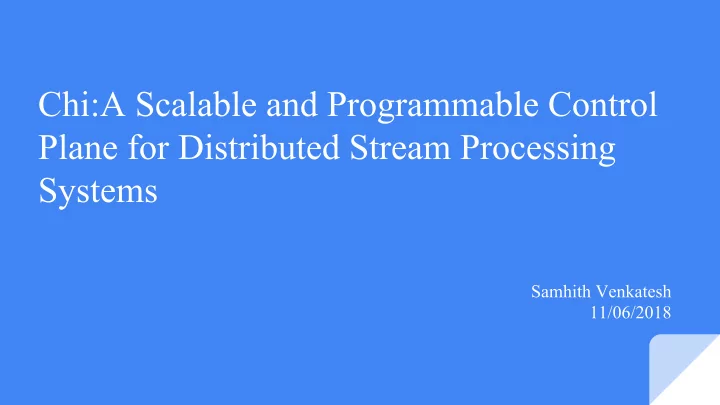

Chi:A Scalable and Programmable Control Plane for Distributed Stream Processing Systems Samhith Venkatesh 11/06/2018
Agenda ● Introduction ● Challenges ● Motivation ● Problem ● Background ● Design ● Implementation ● Evaluation
Introduction
Characteristics Spatial Variability Temporal Variability
Challenges ● Different Service Level Objectives ● Different expectations ● Usability vs Flexibility
Problem Meet various objectives 1. Dynamic Scaling 2. Auto – Tuning 3. Data Skew Management Heron and Flink lack flexibility
How to solve? 1. Efficient and extensible feedback-loop controls 2. Easy control interface 3. Minimal impact on the process
Background Control plane: The control plane is the part of a network that carries signalling traffic and is responsible for routing. Functions of the control plane include system configuration and management Data plane: The data plane is the part of a network that carries user traffic. Data plane traffic travels through routers, rather than to or from them.
Streaming solutions: Naiad , StreamScope and Apache Flink Dataflow Computation Model: A dataflow program is a graph, where nodes represent operations and edges represent data paths. Each node in the graph is represented by triples ( s v , f v , p v ) s v : states of the vertex f v : defines the function which captures computation p v : properties associated with the vertex
Design ● Installable controller and operator API ● Define new custom control operations ● Minimum effort
Design Embedding the control plane into the data plane ● Uses existing efficient data plane infrastructure ● No need of global synchronization ● Facilitate development of various asynchronous control operations
Overview Control Operation: We can consider this as one feedback cycle comprising of a dataflow controller and the dataflow topology Stages involved ● Control decision and instantiation ● Propagation of control messages along with data ● Control message reaches back to controller for post processing
Example: Word Count ● Two map operators {M1,M2} ● Two reduce operators {R1,R2} ● R1 maintains the counts for all words starting with [‘a’-‘l’], and R2 maintains those for [‘m’-‘z’]. ● Controller monitors the memory usage What happens when we have to scale the service?
Control Decision and Instantiation ● Controller detects and makes reconfiguration decision ● Start new reducer R3 ○ R1 - [‘a’-‘h’] ○ R2 - [‘i’-‘p’] ○ R3 - [‘q’-‘z’] ● Broadcast control message to all source nodes
Control message propagation ● M1 and M2 receive and they block input channel and update their routing table. ● R1 and R2 receive and splits data ○ R1 - [‘a’-‘h’] and [‘i’-‘l’] ○ R2 - [‘m’-‘p’] and [‘q’-‘z’] ● Passes the information along with the control message ○ R1 - [‘i’-‘l’] ○ R2 - [‘m’-‘p’]
Control message lifecycle
Graph Transition Introduce a meta topology G`, to complete the transformation asynchronously. State Invariance : No change in node’s state, hence we collapse and merge Acyclic Invariance: Aggressive merge old and new topology ● Check for loops before and after
Operating at scale ● Multiple Controllers - concurrently run on multiple controllers at various stages. Also facilitate global controller ● Aggregation (Spanning trees) to avoid bottlenecks at source and sinks ● To deal with deadlocks we have separate queues ● Fault tolerance ○ Retransmission until acknowledgement ○ Timeout and restart mechanism in-case of network failure ○ Checkpoint and replay mechanism for operator and controller failures
Implementation
Evaluation Synchronous Global Asynchronous Local Chi Control Models Control Models Consistency Barrier None Barrier / None Semantic Simple Hard Simple Latency High Low Low Overhead High Implementation – Low dependent Scalability Implementation – Implementation – High dependent dependent
Thank You
Recommend
More recommend